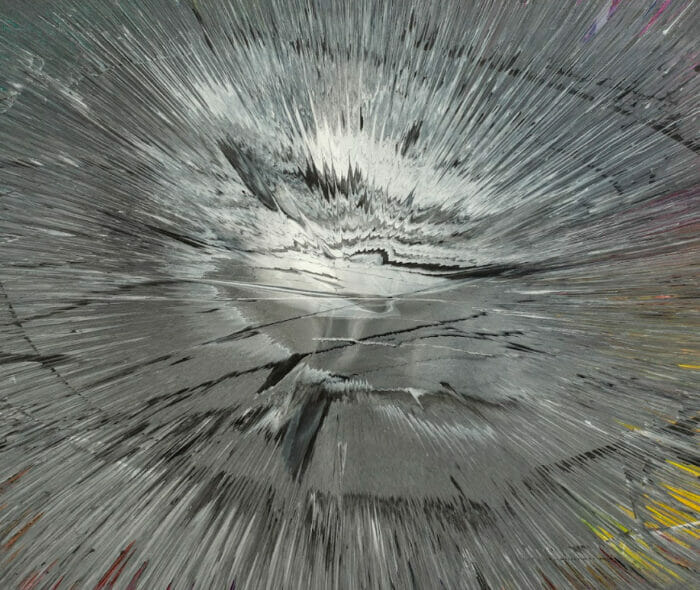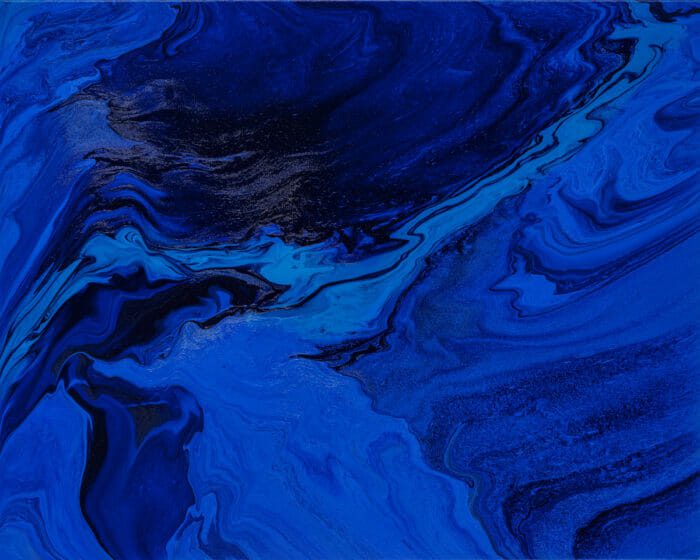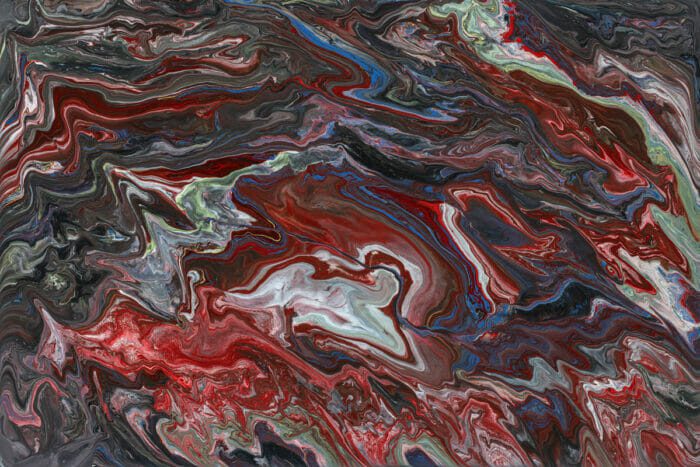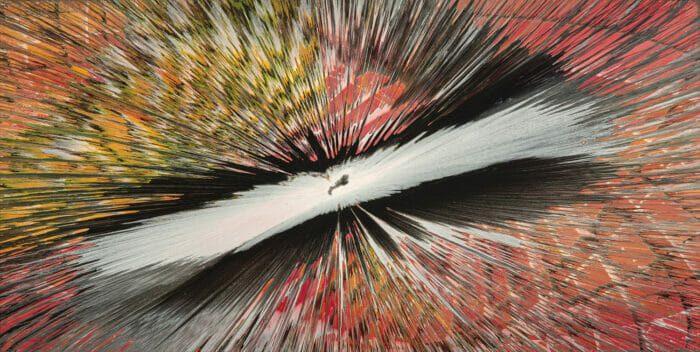
“Since vibration is the basis of all life, these fit perfectly into my cosmology,” Mickey Hart says of the paintings he has been creating over the past few decades.
As befits his lifelong passion for exploring the rhythms of the universe, the drumming icon pours carefully selected paints onto a canvas, then utilizes vibrations to make the colors dance across the surface.
“I’m an enthusiast of low-frequency sound,” Hart observes. “More than an enthusiast, actually, I would say I have a need for it, a hunger for the low-end. So my paintings are driven by those low frequencies. Rhythm is the key to it all. I play on my paintings and watch them create themselves in a way. These creations have a sound because they’re direct reflections of what I do in the day, whether I’m sonifying the cosmos or stem cells. All these things are sonifications, and I use them in my paintings. I also listen to music while I’m painting, so there’s a direct relation. To me, everything is music.”
Hart’s work will be exhibited on a few occasions during his upcoming Dead & Company tour, and he will be in attendance at the Wentworth Gallery in Short Hills, N.J., on June 23. In addition, HeadCount will host a charity auction for one of his works.
A few days prior to the opening of what has been billed as the band’s final tour, Hart reflects on his preparations. “I take every show and every tour very seriously. I train for it, and it takes months to get ready,” he reveals. “So this whole run-up is a very exciting part of that. When I hit that stage, I’ll be better than I was last year and I’ll do things that I’ve never done before. Each night will be a different theme that will be based on a different part of the environment. For instance, it might be the Arctic or a Papua New Guinea rainforest, but there will be 31 different themes. I’ve been working on that a lot. I try to have new material every tour, and I try not to repeat.”
As he considers this, he also takes a moment to reflect on the origins of the “Drums” sequence. “Going back to when this all started, there was never a repeat. In the old days, there was good reason for that. I remember when we dropped the drum solo bit, it started with bacon. I fried bacon in a frying pan. The beginning of it all was a frying pan, bacon and a microphone. Then, Pigpen and I ate the bacon after.”
He laughs, then notes, “So there’s been a giant evolution from bacon to now. It started with bacon because that was all I could think of at the time, but everybody loved it. You could smell the bacon and you could eat it as well. So you could eat your solo.”
As for the paintings, Hart adds, “I sometimes even paint at night when I’m deep into a project because it reflects back into the music—one feeds the other. It’s not any different from what I do in my day job. It’s the visual component to it.”
What initially prompted you to begin painting?
It all began by accident. Many years ago, I went to a toy store to buy a couple of things for my daughter, and on the way out, I saw this kids painting kit. I bought it for her, but she never used it.
Then one day, I picked it up and started painting. I just started moving with the brush and I loved it. I had never worked in the visual domain, but I found myself loving the process of painting. It was a lot of fun, and since I knew nothing, I could do everything. [Laughs.] I wasn’t boxed in. I didn’t have a specific style, so it was like starting over. In music, after you first start, there’s an excitement when you find something that you love and is fun. You can’t stop.
So that’s how it began. Then I learned new techniques and developed what people call vibrational expressionism.

How did your current approach evolve?
Being a rhythmist, I see the world as rhythms. So this was the visual component to my sonic-driven world.
I would work at music all day, then at night, I’d paint. It was kind of an accident, but maybe it wasn’t an accident because it felt really good. Creating something from nothing—that creational moment—is everything. I’m a creational junkie. I love to create things, discover things, and play with sound and light.
I didn’t have a specific technique and I don’t use a brush, so I don’t really paint in that formal respect. Mine is more of a pouring, spinning, vibrating process.
I would vibrate these things into existence and birth them, whether I played on the back side of them, on the frame or, now, I use a subwoofer. I use the monochord, the Beam to drive the subwoofer, which vibrates the paint.
There are many colors within the paint, and the only way for those colors to come up through each other is vibration. That’s what led people to call this vibrational expressionism—every one of these things has been vibrated into existence.
Sometimes I’m on the rim of them playing, trying not to hit the painting itself—although, other times, I do strike the painting and I play rhythms on top of the painting, whether it be with brushes, marbles, you name it.
I love noise. I’m a noisician. The streets are full of noise and I can listen to them forever. As a matter of fact, when Jerry and I were in New York City, we would go and have a hot dog and watch them destroy a building. We’d sit for hours, watching the jackhammers and all the noise in the city.
I’m a musician and a noisician, and I’m also fond of the visual component because I can see music. I see colors in music, and I can hear the paintings. So it’s a synesthetic thing for me.

When you’re creating a piece of work, what is the relationship between the color tones and the musical tones? To what extent is it improvisatory?
It’s totally improvisational except the mixing of the paints, which I focus on in advance. But I’m vibrating these things into existence. Music is controlled vibrations, so there’s little difference. One is light, one is sound. I can see and hear both.
There has to be some kind of forethought when you go into each piece, but I try to limit that as much as I can. Sometimes I conjure what I want it to do. Other times, I approach it as a blank slate because that’s the real fun.
The mixing process is important. You’ve got to know what you’re doing and have your colors in a vibrant place to create these fantastic colors and shapes— so that they can interact with each other. That’s something you learn with practice, and over the years, I’ve learned this technique.

Have you been focusing on a particular form as of late?
I’ve been painting very large, 6, 7, 8 footers. So I have to prepare for the size of it all. Now that they’ve gotten much larger, I’ve created an easel made of steel that can spin. We call it Arco. It can handle the large frames, whether they be plastic, wood or whatever. I first have to manage the size so Arco has to be made ready for the event. So I prepare Arco, then I have my paints, which I’ve prepared, and I take a breath. I breathe real deep. This is a meditation for me.
This is a special thing that borders on the spiritual domain because just like music, it’s a passionate thing. I’m very conscious while I’m doing it, no matter what I ingest [Laughs.] I often get high when I do these things, whether it be mushrooms or cannabis or whatever— these things come from that zone. Then when it’s over, I feel clean. It’s just like music, when you walk off the stage, you’re in an altered stage because with this kind of work, you create a virtual space for it. You go into the trance. Without the trance, you can’t do this stuff. It’s not a casual thing.
You try to think about not thinking. It’s a meditation, it’s a visual kind of a yoga. Rhythm is the key to the whole thing. So these are rhythmic in nature, and there are bits of your subconscious working their way onto a single dimensional world of visuals. It’s that kind of transference.
I’m in a zone. I try to get into the now, into the moment. These are moment paintings. Without the moment, you can’t really function to do these things.
Just as music is a great escape route from reality, these paintings are the same thing. You will see things in them after you look at them for a while that you’ve never seen before. I do it all the time. I look at these things and after they’re done, I see new things in them. Every time I look at them—and I’ve created them—they reveal things that are unseen.
It is a very similar feeling to when you take psychedelics. You get the same kind of high when these images are revealed. Like I said, these things live in a spiritual world. That’s how I paint.

Will you create each of these in one fell swoop?
It’s only rarely that I go back.
It’s like a dose. It’s like a tab, if you will. You get going and then you stay within your own movie. It takes you to another place. It’s a form of transportation.
I do go back from time to time because some of them are in multiple stages. Sometimes you can’t do them all in one session because you have to let one layer dry before you can attempt the second layer. Oils can take months; acrylics dry in a couple of days.
So when you’re working in oils, it requires patience on one hand and on the other hand, you have to be freewheeling. That’s why it’s a yoga. The breath and the stretch is just like when I do my yoga in the morning. I do all of that stuff before I paint, before any one of these sessions. I focus and try to clear my mind of everything.
You have to be open, but you have to have skill. That only happens after years of doing whatever you’re doing. That’s how you acquire technique.
I also dream up color combinations. A lot of these come from dreams because that’s where all of this resides.
These are dream states. Just like with dreams, things happen that you can’t really explain. You might see something that looks like a lion’s head, then you say, “Wait a minute, is it a lion’s head or is it a mountain or a bird?” These things are limitless when you look at them.
That’s the freedom of it all.

Do you find that your work manifests itself in particular eras or creative periods where you’re building and developing specific ideas?
You evolve, just like a musician does. You learn every time you do something. Every time you approach that easel, it’s a new experience. So you try to keep it like that, which is how you gain your skill. Then, once you gain your skill, it’s in your brain. It’s how your neurons are firing. It’s a neurological thing.
You’ll be tested as you go through, just like with any journey. Whether it’s a musical journey or a visual journey, you learn and you progress. Your goal is to learn something from every one.
As you live and evolve as a human being, you change. That’s the way it is with any creative work. So I change and it changes for me. I don’t have to change it, it changes itself because I’m different every day. I let that happen. I never repeat. I try to mix it up.
I use vibrations in the gamma range, 40 cycles. I have an oscilloscope in front of me. So I’m able to see what frequency I vibrate each of the paintings.
I’m using the monochord—the Beam—so I strike the Beam and it goes through a Meyer subwoofer, which is the gold standard. It rests on top of it and I vibrate it accordingly. I have a volume and a pulse knob. I have all the things I use with the Dead, only it’s driving the paintings now. It’s vibrating the paintings into life.
That’s a real interesting thing in itself because gamma is where consciousness comes from—that’s your brain waves.
When you go into gamma, that’s where empathy, consciousness, all the good feelings really lie. So that’s what I try to put into these paintings.
Just like good music, they uplift the spirit. If they don’t do that, then it’s just a bunch of paint.
It’s gotta have that thing, just like good music has that thing. Grateful Dead music has it. The words and the music fit together in a certain way that make you feel elated. You exalt the consciousness in a way.
This is a consciousness-raising experience for me. That’s why I do it.
It’s like when I finish playing music— it’s hard to talk, it’s hard to walk a little bit. I hope that it takes people to another world that mediates life in a way.
I hope it takes them into the zone, into the moment, and allows them to get out of everyday life—out of the aches and the pains with the bills, the world being torn apart and all of those things.
Just like music is a great escape route from reality, these paintings are the same thing. After you look at them for a while, you will see things that you’ve never seen before. They will get you high.
